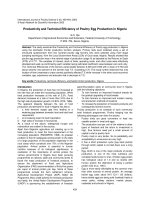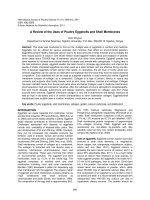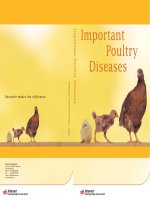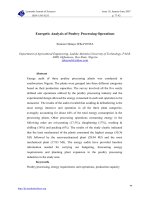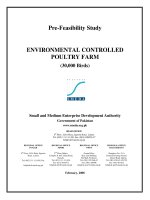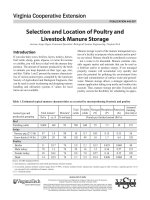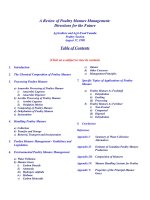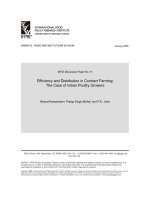Cleaning & Disinfection of Poultry Farm pdf
Bạn đang xem bản rút gọn của tài liệu. Xem và tải ngay bản đầy đủ của tài liệu tại đây (1.01 MB, 39 trang )
Food and Agriculture Organization of the United Nations
Cleaning & Disinfection
fP lt F
o
f
P
ou
lt
ry
F
arm
YiS l
Y
on
i
S
ega
l
FAO Consultant
y
oni.se
g
al
@
fao.or
g
yg@g
A
I Technical Unit
Food and Agriculture Organization of the United Nations
Objectives
By the end of this session, participants will be able to:
• Define farm decontamination - cleaning and
disinfection and explain what each accomplishes
• Describe different
g
rou
p
s of disinfectants
gp
• Describe the safe use of disinfectants and explain the
importance of PPE during cleaning and disinfection
importance
of
PPE
during
cleaning
and
disinfection
• Review the information on a disinfectant
by reading and interpretation of a products’ label
A
I Technical Unit
Food and Agriculture Organization of the United Nations
Cleaning and Disinfection = Decontamination
•
Cleaning and disinfection are key components of
•
Cleaning
and
disinfection
are
key
components
of
routine biosecurity in poultry farming
• Decontamination kills any disease organisms like:
virus
bacteria
bacteria
parasite
mold
mold
that might be present on a farm at the end of a
production cycle or after disease outbreak
production
cycle
or
after
disease
outbreak
A
I Technical Unit
• Decontamination allows for safe re-population of a farm
Food and Agriculture Organization of the United Nations
Exercise:
• The
q
uestions!
Exercise:
q
1
What is a poultry farm cleaning and how its done ?
1
.
What
is
a
poultry
farm
cleaning
and
how
its
done
?
2. What is a poultry farm disinfection and how its
done?
done?
3. How do you choose a disinfectant?
4
What are risks involved in using disinfectants and
4
.
What
are
risks
involved
in
using
disinfectants
and
how to avoid them?
• In your group discuss what do you know about the question
•
Record your key points on the flipchart
•
Record
your
key
points
on
the
flipchart
• Be prepared to present your answer to the group
•
Take about 10 minutes to complete this task
A
I Technical Unit
•
Take
about
10
minutes
to
complete
this
task
Food and Agriculture Organization of the United Nations
Survival of disease causing agents
in the environment
Disease agent Survival time
•
A
vian influenza Da
y
s to months
y
• IBD (Gumboro) Months
•
Coccidiosis
Months
Coccidiosis
Months
• Fowl Cholera Weeks
•
Coryza
Hours to days
Coryza
Hours
to
days
• Marek's Disease Months to years
•
Newcastle Disease
Days to months
•
Newcastle
Disease
Days
to
months
• Mycoplasma Hours to days
•
Salmonellosis (Pullorum)
Weeks
A
I Technical Unit
•
Salmonellosis
(Pullorum)
Weeks
Food and Agriculture Organization of the United Nations
What can kill disease agents?
Detergents / soap
Disinfectants
Sunlight
Sunlight
Heat (direct flame or steam)
A
I Technical Unit
Q
Food and Agriculture Organization of the United Nations
Cleaning
The physical removal of foreign materials like:
- dust
- soil
- organic material such as: droppings, blood, secretions
which
p
rotect disease a
g
ents
pg
Remember!
A good cleaning job will remove 80% of disease agents
A
good
cleaning
job
will
remove
80%
of
disease
agents
A
I Technical Unit
Food and Agriculture Organization of the United Nations
Cleaning - is a two-step process
step 1. Dry cleaning
• Using a broom, brush, shovel, rag or compressed air
to remove dust, soil and dry organic material
R
e
m
e
m
be
r!
eebe
Dry cleaning should not be used for cleaning poultry
houses infected with air
-
born diseases such as: Avian
houses
infected
with
air
born
diseases
such
as:
Avian
Influenza or Newcastle it may cause aerosolization of the
virus and increase the risk of spreadin
g
the disease
A
I Technical Unit
g
Food and Agriculture Organization of the United Nations
step 2 Wet cleaning
step
2
.
Wet
cleaning
• Using detergent/soap and water
soak the area and scrub to remove remaining
soak
the
area
and
scrub
to
remove
remaining
organic material as well as dirt and grease
•
For washing you can use common detergent powder sold
•
For
washing
you
can
use
common
detergent
powder
sold
for cloth laundering – is cheap and effective
Wet cleaning reduces the risk of aerosolization of virus
A
I Technical Unit
Food and Agriculture Organization of the United Nations
Cleaning is improved with:
• Detergents / Soaps
•
Warm water
Warm
water
• Scrubbing
Bhi
•
B
rus
hi
ng
• Power washers
• Steamers
A
I Technical Unit
Food and Agriculture Organization of the United Nations
Remember!
• Disinfectants lose effectiveness during contact with
disease agents
disease
agents
• Organic materials such as manure, blood, dust or dirt
absorb disinfectants and makes them less effective
•
Oitil ttdi t
•
O
rgan
i
c ma
t
er
i
a
l
s pro
t
ec
t
di
sease agen
t
s
You must CLEAN properly before you disinfect!
A
I Technical Unit
You
must
CLEAN
properly
before
you
disinfect!
Q
Food and Agriculture Organization of the United Nations
Disinfection
• Disinfection might kill the remaining disease agents
left after cleanin
g
g
•
Disinfection is the least reliable step of biosecurity
Disinfection
is
the
least
reliable
step
of
biosecurity
,
depends on many factors such as:
•
the quality of cleaning
•
the
quality
of
cleaning
• the hardness of water
•
quality and suitability of disinfectant
•
quality
and
suitability
of
disinfectant
• correct dilution and application
A
I Technical Unit
Food and Agriculture Organization of the United Nations
What are Disinfectants?
Disinfectants are chemicals that
Slow disease agents activity multiplication and their growth
-
Slow
disease
agents
activity
,
multiplication
and
their
growth
or
- Kill disease agents
A
I Technical Unit
Food and Agriculture Organization of the United Nations
Common types of disinfectants
Disinfectants are di ided into se eral gro ps based on their
•
Disinfectants
are
di
v
ided
into
se
v
eral
gro
u
ps
based
on
their
chemical structure
Like:
• Halogens (iodophors and chlorines, halamid®, dettol®)
• Alcohols
• Oxidizing agents (hydrogen-peroxide, hyperox®, virkon®)
•Ph
e
n
o
l
s
(
f
e
nix
®,
Pr
op
h
y
l 7
5®)
eos(e
®, op y 5®)
• Aldehydes (glutheraldhyde – TH4®, formalin)
•
Quaternary ammonium compound (Timsen
® Medisep®
)
•
Quaternary
ammonium
compound
(Timsen
®
Medisep®
)
A
I Technical Unit
Q
Food and Agriculture Organization of the United Nations
Ch i th Ri ht Di i f t t
Ch
oos
i
ng
th
e
Ri
g
ht
Di
s
i
n
f
ec
t
an
t
The choice of disinfectant will de
p
end on the followin
g
:
pg
•Cost
•T
yp
e of disease a
g
ent/s to be destro
y
ed
yp g y
•
Amount of contamination by organic matters such as:
Amount
of
contamination
by
organic
matters
such
as:
droppings, blood and manure left in the poultry house
• Active ingredient
the chemical compound and concentration
that its
contained
A
I Technical Unit
ContCont
Food and Agriculture Organization of the United Nations
•
Dilution and Application rate
Dilution
and
Application
rate
will determine the proper concentration and application
rate of the mixed solution
rate
of
the
mixed
solution
(the correct quantity of disinfectant to be used)
• Contact time
the minimum contact time of the disinfectant with the
surface, to allow for killing of the disease agents
surface,
to
allow
for
killing
of
the
disease
agents
• Safety
To
p
eo
p
le, animals, e
q
ui
p
ment and the environment
A
I Technical Unit
pp qp
Food and Agriculture Organization of the United Nations
Reading the label of disinfectants
• Before using any disinfectant the label MUST be red
and understood
and
understood
.
Th lbl i l bl if ti
•
Th
e
l
a
b
e
l
g
i
ves you va
l
ua
bl
e
i
n
f
orma
ti
on.
A
I Technical Unit
Food and Agriculture Organization of the United Nations
Signal Heading
CAUTION or WARNING
Slightly toxic = S5
CAUTION
or
WARNING
-
Slightly
toxic
=
S5
POISON - Highly toxic = S6
DANGEROUS POISON
Extremely toxic = S7
A
I Technical Unit
DANGEROUS
POISON
-
Extremely
toxic
=
S7
Food and Agriculture Organization of the United Nations
Active Ingredient
A
I Technical Unit
Food and Agriculture Organization of the United Nations
D
irections
for
Use
Directions
for
Use
A
I Technical Unit
Food and Agriculture Organization of the United Nations
Safety Directions
A
I Technical Unit
Food and Agriculture Organization of the United Nations
First Aid
A
I Technical Unit
First
Aid
For additional information look at – www.MSDS.com
Food and Agriculture Organization of the United Nations
Reading the Label
•
Look at the labels provided
•
Look
at
the
labels
provided
Complete the questions
Product Name Active ingredient Rate of Mixing Toxicity Level
1
2
3
A
I Technical Unit
Q
Food and Agriculture Organization of the United Nations
Disinfectants are Dangerous !
• Disinfectants are dangerous chemicals = poisons
• We have to be careful when we use disinfectants
Disinfectants mi
g
ht cause
p
oisonin
g
:
gpg
–
Acute
(fast) toxicity with certain disinfectants may
Acute
(fast)
toxicity
with
certain
disinfectants
may
cause: dizziness, nausea and itchy eyes or skin
– Chronic (slow) toxicity may occur gradually over
many years may cause: permanent disability
A
I Technical Unit
many
years
,
may
cause:
permanent
disability
because the body has become very sensitive
Food and Agriculture Organization of the United Nations
How dangerous a disinfectant is?
Depends on:
• The type of substance and what it is made of
• The s
p
eed and the wa
y
it enters the bod
y
py y
•
The amount of substance that enters the body
•
The
amount
of
substance
that
enters
the
body
A
I Technical Unit


